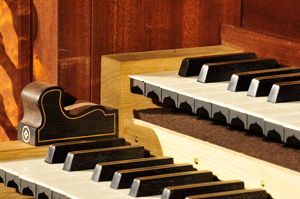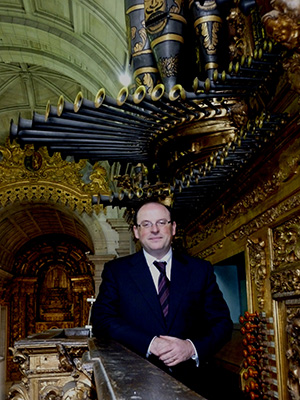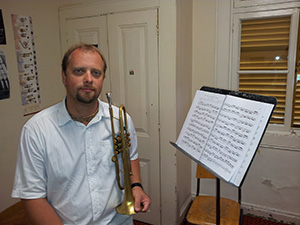 Friday, 18 October, 9.30 p.m.
Friday, 18 October, 9.30 p.m.
Church of São João Evangelista (Colégio)
Filipe Veríssimo: organ
Yevgen Gertsev: trumpet
This concert programme is made up of three pieces for solo organ by Dieterich Buxtehude, Johann Sebastian Bach and Felix Mendelssohn-Bartholdy, interspersed with three works for trumpet and organ by Enjott Schneider. We propose a journey through more than three and a half centuries of music through which we may experience all the fantasy, creativity and, at the same time, the formal strictness, present in most German organ music from the baroque to the present.
A Praeludium (baroque period, northern Germany) is a piece that combines free sections with others based on motives. It is usually in five parts: a free section (Toccata), Fugue, free section (Toccata or recitative), Fugue, free section (Tocata). However, there may be more free sections or, as in the case of the present piece, two fugato sections not divided by free sections. The Praeludium in F sharp minor, BuxWV 146, is considered one of Buxtehude’s masterpieces. It is in a key rarely employed during the baroque period, F sharp minor, one that Bach never used in his organ music.
YinYang is the unification of two opposite poles. The composer’s inspiration came from two imaginary names, Maluma and Takate. Maluma is described as round and soft, while Takate is hard and angular. The same happens in the Toccata, which is a strong, stable and angular work, staccato, while Melisma, a legato work, is graceful and rounded. This polarity is as elementary as “man and woman”. The connection to the YinYang symbol arises from the way in which the melisma and the toccata interconnect and become one.
The evidence suggests that Bach performed the Fantasy and Fugue in G minor, BWV 542 in a competition for the position of organist in Hamburg in 1720. He did not win the position but, fortunately, he wrote down this work for posterity. Since then, various generations of organists have considered it one of the jewels in the crown of the organ repertoire. Fantasy and Fugue were written separately: the fugue is attributed to Bach’s Weimar years (1708-1717) and the fantasy to his time in Cöthen (1717-1723). One may establish a parallel between the Fantasy and Fugue in G minor (BWV 542) and Buxtehude’s work: it comprises five well-balanced sections. Sections of great dramatic intensity alternate with smoother, more contrapuntal sections. The Fantasy, harmonically speaking, has fascinated musicians for more then two centuries. When any kind of harmonic stability seems to arrive, Bach changes tack with a surprising cadence which takes the music to an entirely different dimension. After the Fantasy comes the Fugue, which, similarly harmonically ambitious, is a kind of greatest feat in the field of organ counterpoint. Contrasting in character with the Fantasy, the Fugue may be seen as a stable and pacifying response to the dramatic intensity expressed in the former.
Gethesemane is a meditation of verses from the Gospels according to St Matthew and St Luke which relate the events and the atmosphere lived around the last appearance of Jesus before his arrest in the Garden of Gethsemane. The Gospels tell us that these events were accompanies by supplicatory prayers, repeated three times, which were a kind of warning to keep awake, alert, in preparation for the last hours. The motives are derived from a twelve-tone series and build into a chaconne. Through these one may imagine the repetitive and despairing prayer. The flowing lines of the trumpet refer to the spirituality present in all the actions undertaken by Christ on earth. Christ Who in that moment understand His singularity and solitude in the midst of His disciples.
Mendelssohn wrote six organ sonatas. The Sonata no. 3 in A major is the only one with two movements: Con moto maestoso and Andante tranquillo. The opening and ending of the first movement are made up of the entrance music that Mendelssohn had written for the wedding of his sister Fanny. In the middle is a double fugue based on the Lutheran choral “Aus tifer Not schrei ich zu dir” (Out of the depths I cry unto Thee).
Exclamatio is a work that explores the “shout” in a multifaceted way: at the beginning the shout is like a fanfare, shouting for attention; it becomes a shout of rage, then a shout of longing, a shout of love that, growing, turns into a shout of combat. In the final Adagio, the aggressive motives gradually turn themselves into a lament, or silent appeal. Falling once more into silence, the shout is more efficacious – the Exclamatio more intense.
Filipe Veríssimo
Dieterich Buxtehude (1637-1707)
Prelude and Fugue in F Sharp minor, BuxWV 146
Enjott Schneider (1950)
YINYANG, Toccata and Melisma for trumpet and organ (2009)
Johann Sebastian Bach (1685-1750)
Fantasy and Fugue in G minor, BWV 542
Enjott Schneider
Gethsemane for trumpet and organ (2008)
Felix Mendelssohn-Bartholdy (1809-1847)
Sonata no. 3 in A major
Com moto maestoso
Andante tranquillo
Enjott Schneider
Exclamatio for trumpet and organ (1999)
Participants
|
Filipe Veríssimo (Oporto, 1975) graduated in sacred music at the School of Arts of the Universidade Católica Portuguesa, where he studied organ and improvisation with M. Bernreuther, J. Blasby and F. Lehrndorfer, choral conducting with Eugénio Amorim, Jorge Matta and Jorg Straube, and orchestral conducting with Cesário Costa. He attended various courses and master classes in organ with L. Antoniotti, O. Latry, E. Lebrun, P. Planiavsky, D. Roth and F. Stoiber, and choral conducting with H. Velten. In 2002, he was appointed Titular Organist and Chapel Master of the Church of Lapa (Oporto). Since then he has engaged, in close collaboration with Canon Dr Ferreira dos Santos, in intense activity as a conductor of both choir and orchestra, preparing and conducting some of the most important works in the choral-symphonic repertoire. As organist, he has given several concert tours, most of them as part of national and international organ festivals, in Portugal, Spain, France, Germany, Belgium and Poland. He is a member of an international team or organists which has been undertaking, since 2009, a European concert tour of the work La Révolte des Orgues for grand organ, eight positive organs, percussion and conductor, by the renowned French organist and composers Jean Guillou. He has been awarded the 1st Prize of the First National Organ Competition. He has given the first performances of a number of works by Fr Ferreira dos Santos. |
|
In 1989 he began his studies at a elementary music school, with trumpet as his main instrument. In 1994 he finished the course, and went to the R.M. Glière State Music School of Kiev, attending the wind instrument course. He was a student in the trumpet class of Yuriy Kornilov (principal trumpet in the Kiev Symphony Orchestra). In 1997 he graduated as an orchestral artist, trumpet teacher and director of wind orchestras. In the same year he attended the State University of Culture and Arts in Kiev. In 1999 he was invited to become professor of trumpet in the Music Academy of Graciosa, Portugal. He has participated in many concerts and musical events in Portugal, Hungary, Poland, Ukraine and Germany, as a member of different orchestras and ensembles, including the Kiev Camarata Soloists’ Orchestra, the Symphony Orchestra of the R.M. Glière State Music School, the Wind Orchestra of the State University of Culture and Arts of Kiev, the Madeira Classical Orchestra, the J.S.Bach Festival Orchestra, MAD-Brass, Pestana Big Band and others. |
Notes about the Organ
 Church of São João Evangelista (Colégio), Funchal
Church of São João Evangelista (Colégio), Funchal
This instrument, with 1586 sounding pipes, is situated in a religious space with certain particularities. As a church typical of those belonging to Jesuit colleges, with a broad nave and quite a gentle acoustic, the organ had to be specially conceived, especially with regard to the measurements of the pipes. Thus all the pipework of the instrument has been specifically tailored to produce a full sound, and each stop produces a timbre with an individual personality, forming part of a harmonic ensemble based more on the sound of fundamentals and less on harmonics. It was also felt to be essential to give the instrument a certain ‘latin’ sonority that would favour performance of ancient music of the Italian, Spanish and Portuguese schools of the 17th and 18th centuries.
Another aspect to be taken into consideration was the need to complement the current range of organs available locally: the new organ responds in an ideal fashion to the performance of works of periods and of technical and artistic requirements that none of the 24 historic instruments of Madeira cater adequately for. It also enhances the range of organs that constitute the island’s heritage by being present in this particular religious space, as well as by existing side by side with other historical instruments. In the decision to build it for this church, not only were the issues of acoustic, aesthetic and liturgical space taken into account, but also the presence there of an important historic instrument which is currently on the list of instruments undergoing restoration.
I Manual - Órgão Principal (C-g’’’)
Flautado aberto de 12 palmos (8’)
Flautado tapado de 12 palmos (8’)
Oitava real (4’)
Tapado de 6 palmos (4’)
Quinzena (2’)
Dezanovena e 22ª
Mistura III
Corneta IV
Trompa de batalha* (mão esquerda / bass)
Clarim* (mão direita / treble)
Fagote* (mão esquerda / bass)
Clarineta* (mão direita / treble)
II Manual - Órgão Positivo (C-g’’’)
Flautado aberto de 12 palmos (8’)
Tapado de 12 palmos (8’)
Flautado aberto de 6 palmos (4’)
Dozena (2 2/3’)
Quinzena (2’)
Dezassetena (1 3/5’)
Dezanovena (1 1/3)
Címbala III
Trompa real (8’)
Pedal (C-f’)
Tapado de 24 palmos (16’)
Bordão de 12 palmos (8’)
Flautado de 6 palmos (4’)
Contrafagote de 24 palmos (16’)
Trompa de 12 palmos (8’)
Couplers
II/I
I/Pedal
II/Pedal
* horizontal reeds
 Filipe Veríssimo
Filipe Veríssimo Yevgen Gertsev
Yevgen Gertsev